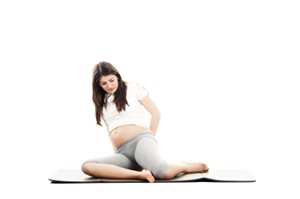7 Natural Remedies To Relieve Pregnancy Back Pain

Back pain is a common problem during pregnancy. Between the weight gain, the change in your center of gravity and the changes in hormones that lead to relaxation of your ligaments, it’s unsurprising that so many women experience back pain. Luckily, there are a range of natural remedies you can try to help ease the pain and make your pregnancy more comfortable.
Exercise
Engaging in some gentle exercise can help to prevent your muscles from becoming too tight. Swimming is one of the most highly recommended types of exercise for pregnant women. The sense of weightlessness in the water allows your spine to decompress and the swim helps to gently tone your arms, legs, core and back muscles. Towards the end of your pregnancy, avoid excess breaststroke kick.
Prenatal yoga is another popular exercise choice, as it allows you to improve your posture, as well as tone your body. Engaging in some gentle yoga can also help to improve the quality of your sleep, whilst relaxing both your muscles and your mind.
Improve Your Posture
Improved posture can greatly reduce back pain. Whilst standing, think tall and imagine a string pulling you up towards the ceiling , and feel the weight of your feet evenly from side to side. You should also aim to stand with your feet hip-width apart. When sitting, again feel the evenness from side to side, use a cushion to support the curve in your lower back or try to stay close to the edge of the seat to help you sit upright. When possible avoid sitting for too long, and break up your sitting position by getting up and taking a walk or stand up and do a few gentle stretches.
Prenatal Massage
As well as relieving pain, prenatal massage has also been shown to alleviate anxiety and depression during pregnancy. The Swedish massage technique tends to be the most advisable during pregnancy because it uses long, smooth strokes and is both gentle and soothing. However, you should only have a prenatal massage from a certified therapist who is trained in pregnancy massage and check with your doctor or health care provider to ensure that the massage is safe. You can also try to use a foam roller at home to help loosen your calves, hamstrings and glutes. After 16 weeks of pregnancy, do this while sitting, because lying on your back for exercising is no longer recommended.
Invest In Sleep Support
Once your pregnancy has developed past the first trimester, side sleeping becomes increasingly important, although it can often become uncomfortable.
“You should try to minimize sleeping on your back. One way to do this is to use pillows to get comfortable and prevent you moving too much. You should make sure that your mattress is supportive and where possible, try to maintain a consistent sleep schedule and routine,” explains Hannah Pletcher, a journalist at Assignment Service and Top assignment writing services in Victoria. “The best way to support your spine during sleep is to use some form of sleep support. You can place a pillow between your knees and lower legs to help reduce the strain on your lower back and pelvis or use a full body pregnancy pillow.”
Wear Supportive Garments
Make sure that you are wearing appropriate, supportive gear during your pregnancy. Wear comfortable and supportive shoes. Low-heeled shoes are the best as they help to distribute the weight on your legs. Avoid wearing high-heeled or flat shoes. Too restrictive for people - flat shoes with arch support would be fine, but high heels, though some people really like them, are bad to wear for for long periods of time, because they are actually designed to bend your pelvis forward, which causes pain through putting stress on your back. High heels can make you more unstable as your pregnancy progresses so if that happens, head into wearing flatter more supportive shoes.
Maternity belts are also another popular supportive garment. They function as a supplement for your core abdominal muscles and help to support your lower back and pelvic girdle hold up your belly, so that your lower back and pelvic girdle are less strained. Your health care professional can advise you on how much to wear a maternity belt depending on any pain that you are experiencing. Avoid wearing a maternity belt all day. Instead, use it during taxing activities and as a complement to other pain-relief strategies.
Engage In Meditation Or Mindfulness Techniques
One of the most appealing aspects of mindfulness and meditation techniques is that they can be practiced anywhere, at any time.
“There are many ways to practice meditation and mindfulness, but the focus is predominantly upon the breath and breathing deeply and mindfully,” says Mary Thompson, a health expert at Simplegrad and Essayroo. “The main benefit is that it has been shown to help reduce pain. By undertaking regular meditation, you can actually increase your pain tolerance level. Not only will this help you to manage any back pain you may be experiencing during pregnancy, but it is also a fantastic coping strategy to use during labor.”
Consider Complementary Treatments
If you are experiencing acute back pain, consider using some complementary therapy treatments, such as chiropractic care, physiotherapy or acupuncture to help relieve some of your discomfort and pain. You should always discuss this first with your doctor and ensure that any chiropractor, physiotherapist or acupuncturist not only knows that you are pregnant, but has been specifically trained to provide treatment to pregnant women.
Beatrix Potter is a health writer at both Big Assignments and College Assignment Help writing services. Bea regularly writes articles about motherhood, female health and how to overcome issues faced during pregnancy. She also tutors students at all stages of their education at Essay Writing website.